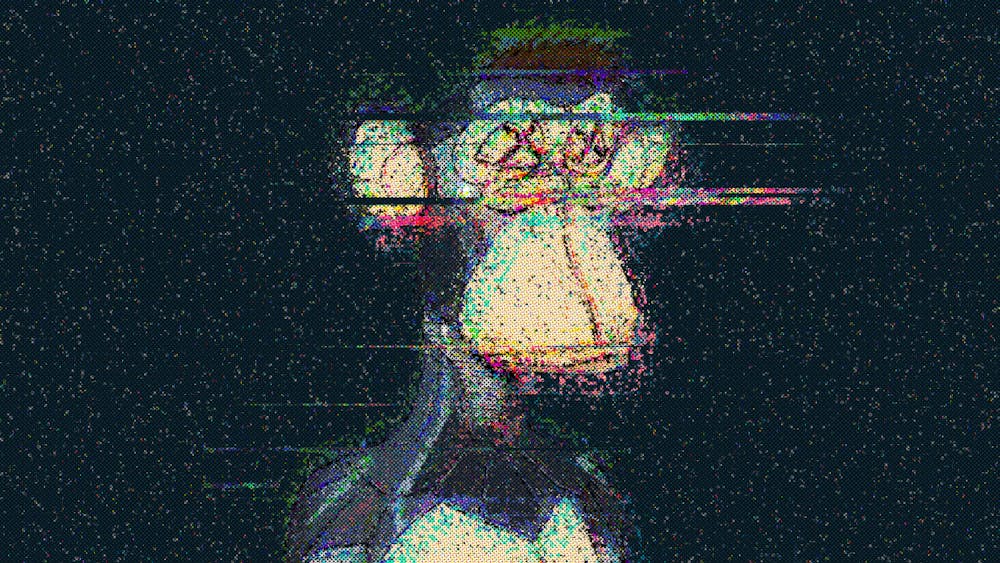
With the rising prominence of cryptocurrency over the past decade, in both the financial sector and societal consciousness, the emergence and popularization of NFTs is no surprise. And while these non-fungible tokens have been seamlessly integrated into popular culture through sensationalistic reporting and social media crazes — even more so within institutions with a strong financial psyche like Penn — I am left with a persisting question: Is it merited?
Separate from financial arguments about the expanding role of cryptocurrencies and related blockchain technologies, NFTs — particularly art as NFTs — represent an especially problematic innovation and slippery cultural slope. In order to understand how NFTs challenge traditional notions of art, one has to understand NFTs themselves.
To this end, NFTs are essentially non-fungible (meaning they are unique and cannot be replaced) digital assets that represent both tangible and intangible items. Additionally, they are bought and sold online and even underlaid by the same blockchain technologies as many cryptocurrencies. However, what differentiates NFTs from fungible cryptocurrency is that the blockchain (typically Ethereum) used to verify ownership, “mints” and in turn ensures the originality of each NFT, the primary basis of their value.
And therein lies the fundamental issue of art as NFTs: artistic value based in blockchain technology as opposed to traditional considerations of cultural and historical impact. More significantly, the NFT craze shifts artistic motivation to the merely financial, away from art for art’s sake. While NFTs represent the commercialization of art for the purpose of circulating money, other forms of art derive their value from their beauty, ability to challenge our ways of thinking, and power to portray or critique the sociohistorical context, among many other factors.
Moreover, the originality that blockchain imbues NFTs with diminishes artistic cultural value into novelty value — a somewhat elitist conception of art. Essentially, because the NFT has value, the art itself need not. And yet, the average person cannot own NFTs as expensive as Beeple’s, for example, which sold for $69 million at Christie’s in 2021. So if the sole value of a piece of art becomes contingent on owning the original, then NFTs distort the communal value of art as an experience by making the market based on ownership and thus highly exclusionary.
Conversely, although a copy of Veronese’s "Wedding Feast at Cana" could not be sold for the same price as the one which hangs in the Louvre, the art itself can still evoke similar emotions, thoughts, and reflections. But NFTs aren’t concerned with such things and instead shift importance to the politics of ownership which limits the possibility of any cultural value separate from that very fact. In NFTs, gone is a cultural value derived from collective appreciation or emotional representation.
A quote I find particularly relevant on the importance of art is from Jeanette Winterson, an English writer. She says, “What art does is to coax us away from the mechanical and toward the miraculous. The so-called uselessness of art is a clue to its transforming power. Art is not part of the machine. Art asks us to think differently, see differently, hear differently, and ultimately to act differently, which is why art has moral force.” Indeed, my own conception of art and its power aligns quite closely with Winterson’s. What makes art as an object and process beautiful to me is that it is both completely unencumbered by, and yet entirely inseparable from, the social moment, endowing it with a power to transcend geography, language, and epochs.
Although one could assuredly argue that the Nyan Cat GIF or Bored Ape #0-9999 are cultural artifacts of the digital age, do they perform the dual function of coaxing us “toward the miraculous”? I would argue they don’t. Neither of these, nor the countless NFTs I have seen, have changed the way I see or interact with the world. No NFT has taken my breath away the way a Raphael does or made me reflect the way an Aivazovsky urges me to. And of course, beauty is ultimately in the eye of the beholder, but the fact that major artists and collectors, including the highest-valued living painter David Hockney, have completely dismissed NFTs as legitimate art, speaks volumes.
Despite all of this, NFTs do allow art to become a financially viable occupation for many artists who have struggled in recent years, and also historically, in a world where patrons of the arts have become increasingly less commonplace. But in this, the question becomes: where do we — and more importantly, artists — draw the line? At what point is art being produced on the basis of commerciality and not for the sake of itself? NFTs cannot become a mechanism for forcing artists back into the capitalistic hierarchies that define the rest of the market. After all, “art is not part of the machine.”
Then what picture of NFTs are we left with? In my eyes, it's an emerging technology that perverts the intrinsic value of art for art’s sake while simultaneously commercializing artistic creation. So, please excuse me if I don’t subscribe to the hype.
VINAY KHOSLA is a College first year studying philosophy and political science from Baltimore. His email is vkhosla@sas.upenn.edu
The Daily Pennsylvanian is an independent, student-run newspaper. Please consider making a donation to support the coverage that shapes the University. Your generosity ensures a future of strong journalism at Penn.
Donate



